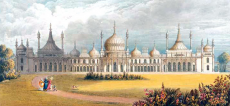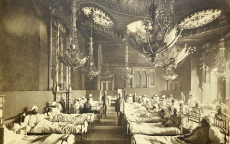
The Royal Pavilion is an exotic palace and Brighton and Hove’s most distinctive landmark. As well as being a major tourist attraction and an iconic feature of the city, the Pavilion also has a fascinating history.
The building started life as a small lodging house in the humble fishing village of Brighthelmstone. In the late eighteenth century the village developed into a seaside retreat for the rich and famous, with many travelling south from the nearby capital. The work of physician Richard Russell on the curing properties of sea water was a huge influence. In 1753 he moved his practice to Brighton, and claimed that the water there was more effective than inland spas like Bath. Soon the city was a population destination both for health and leisure.
Foremost among the eminent visitors was the Prince of Wales, George. Besides enjoying the restorative seawater, his decadent lifestyle and love of parties made Brighton an ideal home. In the mid 1780s he purchased a small house and hired famous architect Henry Holland to transform it into a luxury villa called the Marine Pavilion, in the Neoclassical style. This was a popular architectural style in the late eighteenth century, echoing Roman and Greek classical temples. George lavishly decorated the interior with Chinese imported furniture and objects, including beautiful hand-painted wallpaper. The fashion of ‘Chinoiserie’ was another population style at the time: George was certainly a trendy guy.
In 1808 the Prince commissioned William Porden to design a huge new stable complex in the ‘Indian style’. The building had a lead and glass-domed roof, and could house up to 62 horses. The stable remains standing today, but is now the Brighton Museum and the Dome theatre and concert hall. In 1811 George became Prince Regent when his father, George III was declared incapable of acting as monarch; the cause of his mental illness is still unknown. As Regent, George had a lot more money and power, and so he commissioned the renowned architect John Nash to transform his ‘humble’ villa into an oriental palace to match the stables. Nash added a huge cast iron frame around the original building to support the minarets, domes and pinnacles which give the Pavilion its distinctive shape. He made sure that the palace had all the latest conveniences, including gas lighting and indoor plumbing. Finally, it was completed with the most opulent decorations possible, all in the ‘oriental’ style.
All of this activity had a great influence on the development of Brighton. The building work on the palace itself provided jobs for local tradesmen. When George moved in and brought his Royal Court with him, the influx of high society as well as all the members of the royal household made the population swell. This in turn created a lot of business for locals, including more building work. This period was key in shaping the character of Brighton, with many of its famous Regency squares and crescents built at this time.

After George’s death, the palace was used infrequently by his successor William IV and next by Queen Victoria. Neither were quite as ostentatious as the Brighton Prince, and found the Pavilion unsuitable for their needs. Victoria finally sold the building to the town of Brighton in 1850 for £50,000. She imagined that it would simply be torn down, and so stripped it of its decoration and furniture before she left. However, the tourism to the city remained high, and the Pavilion continued to be visited. It was used as a venue for fetes, bazaars, shows, balls and exhibitions, with an early version of the Brighton Museum on the second floor. The council began to redecorate it in a similar style to George’s day, and in 1864 and 1899 Victoria returned many of the original items.
The redevelopment of the Pavilion was put on hold for the duration of the First World War. From 1914 to 1916 it was used as a hospital for injured soldiers from the Indian Army (pictured), who provided the largest number of troops of any part of the British Empire. The palace had 600 hospital beds and X-ray equipment installed, and the Great Kitchen became an operating theatre. The ‘princes and people of India’ would later give the ornate India Gate to the Pavilion in gratitude for the hospital’s care. In 1916 it became a hospital for British soldiers who had lost limbs, aiming both to care for them and help them reintegrate into society.
Since the end of WWII the Pavilion has been completely restored, and is now a popular tourist attraction. On 29th March 2015 it was again the site of an important historical event, when Andrew Wale and Neil Allard celebrated the first gay wedding in the city in the palace’s Music Room.
Images: http://www.victoriana.com/Travel/images/royalpavilion-8.jpg
http://i.telegraph.co.uk/multimedia/archive/03005/SUMM_ha903303_d01__3005041b.jpg

0 Comment:
Be the first one to comment on this article.